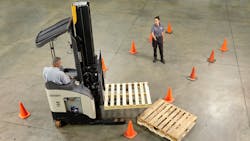How Effective Is Your Forklift Safety Training?
A fragmented and inconsistent approach to safety is inadequate when applied to today’s dynamic, fast-moving work environments. The result can include increased risk to employees, disruptions in operations, damaged equipment and exposure to compliance issues.
Implementing an integrated and individualized approach to a safety training plan can help bring a consistent focus to safety management. It also stresses the important role everyone plays in creating and maintaining a safe work environment.
A robust training program is a vital component of an integrated and individualized approach to safety. It needs to be a program designed to do more than simply check a box on a safety checklist. The effectiveness of a forklift safety training program can vary significantly depending on how it is delivered and who within the organization is receiving it.
Effective safety management requires extending training beyond forklift operators to include managers, supervisors and pedestrians, and making it readily accessible and convenient for everyone involved. By focusing on both comprehensive classroom and hands-on training, training programs have the potential to encourage meaningful behavior changes that can enhance warehouse safety and form the foundation for a strong safety culture.
Additionally, taking a top-down approach to forklift safety training is an effective method to increase organizational buy-in and effectiveness while helping to communicate the importance of a comprehensive and integrated approach to safety.
Organizations need to continually evaluate safety programs to minimize gaps in training, as well as to ensure that everyone has an understanding of the role they play in your organization’s safety culture.
To identify gaps in your training, you can evaluate your current program by asking the following questions:
1. How effective is the training you are delivering?
Relying too much on classroom training and not providing hands-on training can limit the ability of operators to translate learning into practice. The classroom can provide the foundation, but new skills are best internalized when operators can get on a forklift and apply their new knowledge under the supervision of an experienced trainer. A fleet and operator management system can support training effectiveness and evaluations and help identify improvement opportunities.
2. What is the frequency of your safety training?
Like any form of education, the positive effects of safety training can erode over time. In the United States, OSHA states that training is required every three years, at a minimum, but more frequent refreshers can have positive effects. Establish a frequency for operator refresher courses and maintain discipline in ensuring established guidelines are followed. As much as possible, integrate regular training into your operations, leveraging online learning systems that allow operators and supervisors to regularly refresh their knowledge at their own pace with minimal disruption to operations.
3. Are new operators receiving training in a timely manner?
In today’s fluid job market, you will inevitably see some transition in your team of operators. It is essential to have a process to ensure new employees receive the training they need early in onboarding. Some forklift telematics systems can provide real-time feedback to operators that reinforces correct behavior and recognizes incorrect behavior. They can also give supervisors the performance data they need to showcase exemplary operators and their good choices while also identifying areas for additional training.
4. Are supervisors trained to identify and address incorrect operating practices?
Positive reinforcement by supervisors can be one of the most effective methods for sustaining safety improvements initiated by formal training programs. However, supervisors must be appropriately trained to spot incorrect behavior and deliver positive and constructive feedback in a way that creates long-term behavioral changes.
5. Are non-operators trained to work safely around forklifts?
Forklift operators are not the only ones who could be involved in forklift-related accidents. Distracted or inattentive pedestrians can also put themselves in harm’s way. A comprehensive approach to training should include those team members who work around but do not operate forklifts. This training helps pedestrians better understand the “do’s and don’ts” of working in environments where forklifts are present.
6. How is training being used to support the introduction of new technology?
As you introduce new technologies into your operations, training plays a key role in accelerating adoption and addressing safety considerations associated with the new technology. Training may even help realize the benefits associated with the new technology. Listening and collaborating with front-line workers can help determine if additional adjustments to training programs regarding the new technology are required.
7. How is new technology being used to support your training?
Several operator-assist technologies are available on today’s forklifts that can work passively or actively to reinforce training and guide operators to employ best practices consistently. Advanced sensors and software can adjust forklift performance parameters based on the load, task, location and environment to promote safe, productive operations. For instance, a system that uses Lidar sensors installed on the lift truck that scan for objects, pedestrians and other forklifts to alert the operator of their presence and actively slow the vehicle.
8. Do you have the resources and expertise to manage training in-house effectively?
Effective training requires a high degree of expertise in equipment operating practices and how people learn—in addition to the time to plan, execute and manage training programs. Even the best designed training programs can be derailed or lose effectiveness if internal resources don’t have the expertise, up-to-date knowledge and time to prioritize it.
Training is a fundamental element of the safety equation and is vital to building and maintaining a strong safety culture. Asking these eight questions of your training program can help you identify gaps in your training that need to be addressed to help leverage your investment in safety and implement a successful safety program.
Stephanie Kovach is director of training with forklift manufacturer Crown Equipment.
About the Author
Stephanie Kovach
Stephanie Kovach is director of training with forklift manufacturer Crown Equipment.
